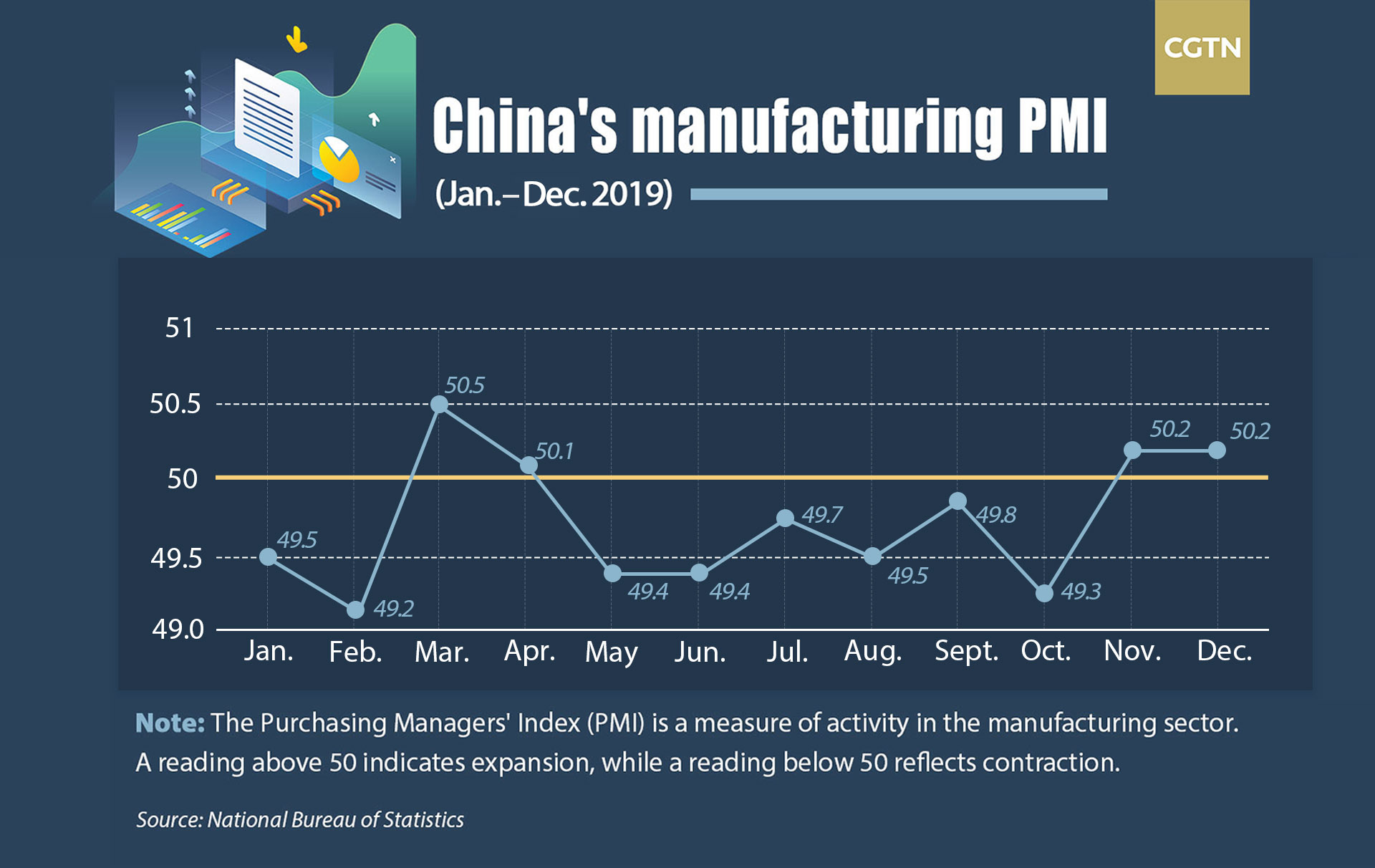China's factory activity expands for second month, PMI at 50.2
Factory activity in China expanded for a second straight month in December at 50.2, as production quickened and export orders rose, official data showed, implicating vast recovery of the Chinese business environment.
The purchasing managers' index (PMI) for China's manufacturing sector stood at 50.2 in December, the National Bureau of Statistics (NBS) said Tuesday.
This marks the second straight month of expansion, partly buoyed by booming supply and demand as well as increasing export orders, NBS senior statistician Zhao Qinghe said.
On a month-on-month basis, the sub-index for production gained 0.6 points to 53.2 in December, signaling faster expansion.
Imports and exports were improving in December, said Zhao, as the sub-index for new export orders gained 1.5 points to 50.3, the first expansion since June 2018. The sub-index for imports climbed 0.1 point month on month to 49.9.

In December, the PMI of high-tech manufacturing, equipment manufacturing, and consumer goods all rose for the third straight month, showing accelerated transformation and upgrades, said Zhao.
The PMI for China's non-manufacturing sector came in at 53.5 in December, down from 54.4 in November, a separate report by the NBS showed on Tuesday.
Domestic demand many have risen from the cyclical bottom
The reading is above 50 for a second month, pointing to a sustainable recovery in manufacturing sectors amid easing in U.S.-China trade tension, according to Jimmy Zhu, chief strategist at Fullerton Research.
Apart from improving external outlook, the domestic condition remains in stabilization mode. New orders continue staying in the expansionary range at 51.2, while the output components rise to 53.2. Improving readings in these two components almost confirmed a solid recovery in domestic demand, after the policymakers introduced various measures on both monetary and fiscal front to boost the growth activities, Jimmy Zhu told CGTN.
Zhu said that Chinese economy has reached the cyclic bottom, with hopes of improving U.S.-China trade outlook. Moving into 2020, news on the two countries that have reached more consensus on the trade agreement will largely remove the business uncertainties.
PMI's purchase quantity index rises to 51.3 from earlier 51.0, while the inventories of finished goods dropped by 0.8 percentage point to 45.6. These sets of data suggest local companies have been encouraged to further expand the business investment, together with the current increasing infrastructure projects.
Medium-sized companies outperform
The sub-index has risen for a fourth consecutive month. Manufacturing PMI for medium enterprises surged to 51.4 in December, above the key 50-threshold for the first time since August 2018, and the reading is the highest since May 2014. Zhu said that the outperforming in this category of companies reflects the following factors.
Firstly, stabilization in the stock market. The sample of the official PMI's survey is unknown, but many middle-sized firms in the survey could be those public listed firms, with a substantial amount in the secondary board. Thus, the main source of the funding for these companies would be from the equities instead of traditional banks' lending. Shanghai composite index has rallied 5.8 percent since end of November, and Chinext has gained 8.1 percent in this period. Also, rising stock prices directly improve these companies' balance sheets and bolster confidence among business owners.
Secondly, improving global demand. With the details of the survey sample, it's difficult to tell which group of the companies among the large, medium and small-sized have the biggest exposures to the overseas market. However, analysis shows that medium-sized companies' PMI has the highest correlation with Caixin manufacturing PMI, whose sample is well-known for those export-oriented companies. Correlation between these two stands at 0.493 in the past five years, versus 0.481 between Caixin PMI and official PMI for large-sized companies, and -0.114 between Caixin PMI and official PMI for small-sized companies. Meanwhile, official PMI's new export orders jumped to 50.3 this month from previous reading at 48.8, another confirmation that outlook for Chinese exporters is much improved this month.
PBOC's policy will be more targeted-base
Zhu also said that the overwhelming PMI data suggest the PBOC's monetary policy is likely to stay prudent in the near term. After the required reserve ratio for major banks has been reduced by 400 bps in the past two years to 13 percent, the central bank may prefer to use more targeted-based measures to support the economy.
Today's PMI shows small-sized companies' outlook remains challenging, with the PMI for this group of companies declined to 47.2. Higher output prices are one of the reasons, and recent rising interbank funding costs also matter for small-sized companies, given their funding heavily relies on bank lending, said Zhu.
Interbank 7-day repo rate jumped 52 bps this month to 3.025 percent. Thus, the central bank is expected to inject more liquidity through the existing credit facilities, such as MLF and OMOs (Open Market Operations), to encourage banks to increase lending to small businesses, said Zhu.







